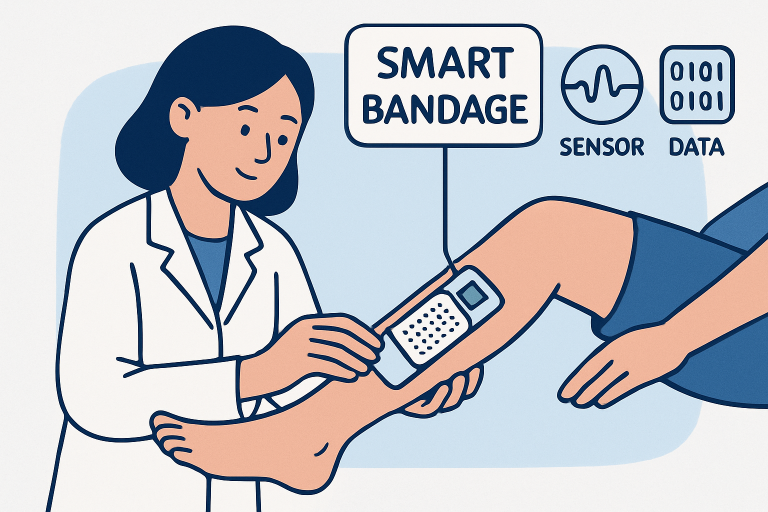Key Takeaways
- Modern wound care technologies expedite healing and improve safety for chronic wounds.
- Smart bandages, artificial intelligence, and telehealth reshape how wounds are treated and monitored.
- Innovations in materials and digital health are supporting better patient experiences and outcomes.
Table of Contents
- Introduction
- Smart Bandages: Real-Time Monitoring and Treatment
- AI Integration in Wound Assessment
- Telehealth and Remote Wound Management
- Bioengineered Skin Substitutes
- Electrical Stimulation Therapy
- 3D-Printed Wound Dressings
- Conclusion
Introduction
Chronic wounds, including diabetic ulcers and pressure injuries, present significant challenges for patients and healthcare providers. Extended healing times, infection risks, and the toll on overall healthcare resources amplify the need for new treatments. In recent years, cutting-edge advancements have begun to transform the landscape of wound care. Today, more patients are experiencing improved healing rates, fewer complications, and a higher quality of life thanks to next-generation approaches at a modern wound care clinic.
The latest breakthroughs in chronic wound care—such as smart monitoring devices, artificial intelligence, remote management, and advanced dressings—are making treatments safer and faster. These innovations, rooted in real-time data and enhanced personalization, revolutionize care protocols and patient engagement. By integrating technology with time-tested wound care principles, healthcare professionals gain powerful new tools to optimize healing and significantly reduce recurrence risks.
Increased research and investment in wound management systems across the healthcare sector support the rapid adoption of these new technologies. According to the journal Nature, advancements in biosensors, data analytics, and tissue engineering are paving the way for the next generation of competent wound care.

Smart Bandages: Real-Time Monitoring and Treatment
Smart bandages are transforming how chronic wounds are monitored and treated. Outfitted with embedded sensors, these advanced dressings can track temperature, pH, and moisture at the wound site—providing instant feedback to clinicians and patients. When unusual readings arise, healthcare providers can intervene promptly, preventing infections before they escalate. Some smart bandages are also engineered to dispense precisely-timed doses of medication directly onto wounds, streamlining care and supporting optimal healing environments. Researchers at the Keck School of Medicine of USC are at the cutting edge of these developments, designing devices that offer real-time insights for chronic wound care.
AI Integration in Wound Assessment
Artificial Intelligence (AI) is pivotal in modern wound care because it allows for the rapid, accurate analysis of medical images and patient data. AI-powered wound assessment tools can identify subtle changes in wound status, predict healing trajectories, and even flag cases that require specialist input. By leveraging machine learning, clinicians can create more detailed, individualized care plans and avoid the risks associated with manual data entry errors. The Deep Multimodal Wound Assessment Tool (DM-WAT) demonstrates the capability of AI to enhance referral processes and support ongoing patient management. Read the complete study here.
Telehealth and Remote Wound Management
Telehealth solutions have become increasingly important in wound management, especially for patients in rural or underserved areas. Through secure video calls and remote monitoring platforms, clinicians can assess wounds, provide expert advice, and teach patients and caregivers how to carry out essential wound care tasks. This improves healthcare access while reducing the need for hospital visits and lowering exposure to infectious diseases. Mobile wound care apps and online tutorials enhance patient education, giving individuals more autonomy over their recovery while staying connected with clinical support.
Bioengineered Skin Substitutes
Bioengineered skin substitutes represent a significant leap forward in tissue regeneration for chronic wounds and extensive burns. These advanced dermal products are crafted to replicate the properties of human skin, providing scaffolds for new cellular growth and protecting against further wound damage. Commercially available products such as Apligraf® and Dermagraft® have demonstrated effectiveness in speeding up tissue regeneration and reducing infection rates. Healthcare providers are increasingly turning to these tools for patients with non-healing or complex wounds, as noted in National Institutes of Health resources.
Electrical Stimulation Therapy
Electrical Stimulation Therapy (EST) uses gentle electrical currents to initiate and promote healing at the cellular level. This noninvasive technique enhances blood flow, reduces inflammation, and accelerates the growth of healthy tissue—particularly valuable in hard-to-heal wounds seen in patients with diabetes or vascular deficiencies. EST is essential to multidisciplinary wound care, complementing traditional therapies and supporting improved patient outcomes.
3D-Printed Wound Dressings
3D printing technologies are catalyzing innovations in wound dressings, with the ability to craft custom-fitted covers that closely match each wound’s dimensions, shape, and complexity. These dressings can be infused with antimicrobial agents, growth factors, or pain-relieving medications, offering targeted and efficient therapy directly to the wound site. The customization—and potential integration of biosensors or drug delivery—sets 3D-printed dressings apart as a highly personalized and effective solution.
Conclusion
The future of chronic wound care is being rapidly reshaped by technology. Advances such as smart bandages, AI-driven assessments, telehealth, bioengineered skin, EST, and 3D printing empower clinicians and patients alike. As adoption of these innovations continues to expand, chronic wound care is set to become safer, faster, and more accessible. With ongoing research and collaboration between technologists and healthcare leaders, patient outcomes stand to improve dramatically in the years ahead.
The Editorial Team at Healthcare Business Today is made up of experienced healthcare writers and editors, led by managing editor Daniel Casciato, who has over 25 years of experience in healthcare journalism. Since 1998, our team has delivered trusted, high-quality health and wellness content across numerous platforms.
Disclaimer: The content on this site is for general informational purposes only and is not intended as medical, legal, or financial advice. No content published here should be construed as a substitute for professional advice, diagnosis, or treatment. Always consult with a qualified healthcare or legal professional regarding your specific needs.
See our full disclaimer for more details.







